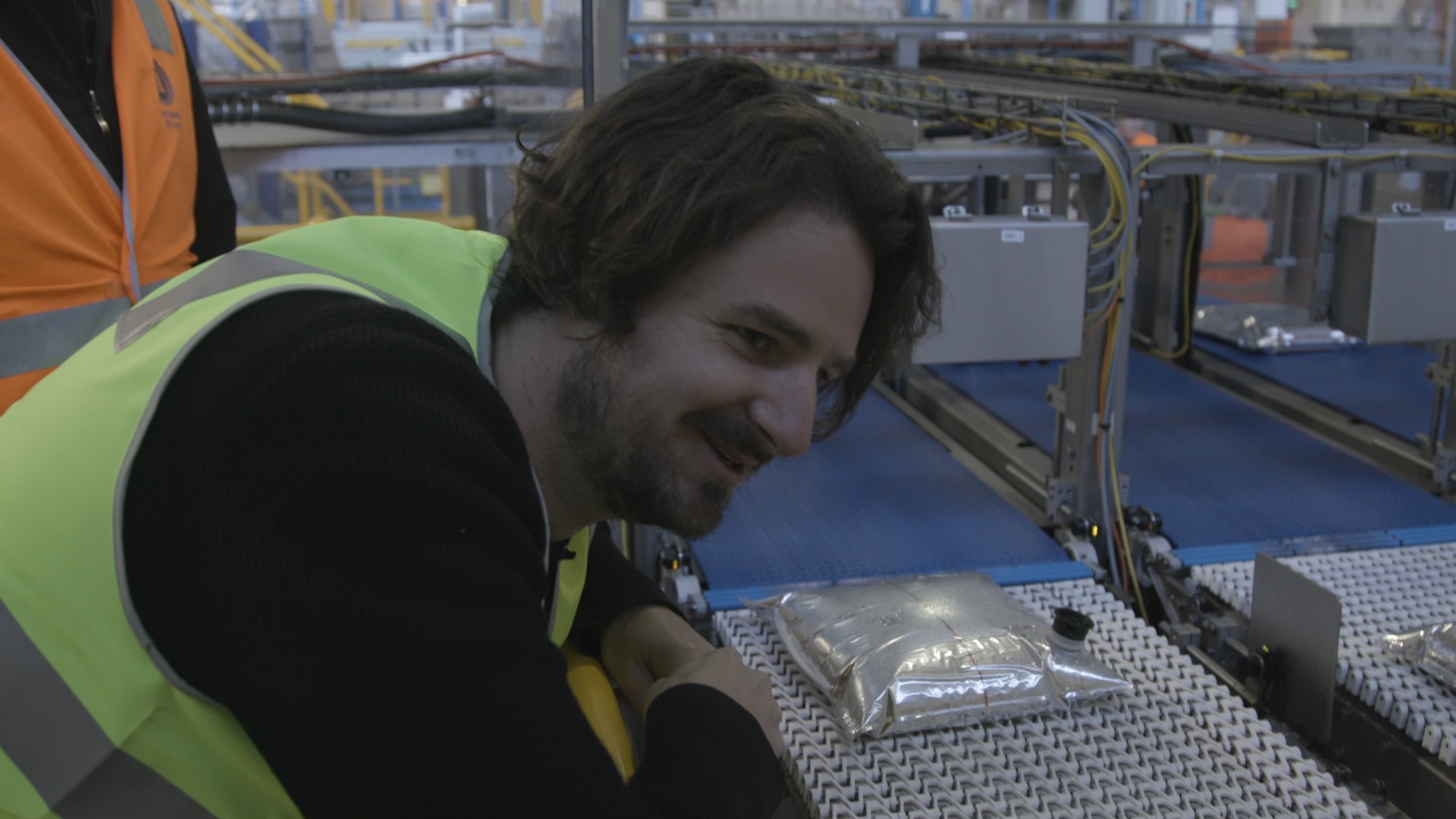I've always loved goon. I truly believe that with the right box poured in the right way, life can be better. Mild acquaintances can become brothers, catch-ups can become orgies, and simple clothes lines can whirl you into states of irresponsible joy. To open a box of goon is to open a night. It's your keys to the city. It's a way to make the music play louder, and mostly play that one song by Third Eye Blind.
But, of course, some people don't appreciate goon. Just like some people don't appreciate how "Semi-Charmed Life" was the song of a generation. These are the people who strut around at parties wearing boat shoes, saying things like, "Is that cooking wine?" Which is an annoying question, because we all know what they're really saying. What they're really saying is: "Goon isn't cool."
And they're right, but that's the whole point. In 2017, when the whole universe is so hung up on natural orange wines and west coast IPAs—that honestly just taste like they've put a tree through a juicer—it feels to me like goon is the working man's last drink. It's the only drink with a sense of humour. Goon doesn't give a shit if you're into turmeric lattes. Goon doesn't give a shit if you're well read. The only thing goon cares about is whether you party.
So, clearly, I love goon, and somehow I managed to convince work to send me on a sort of pilgrimage to Australia's home of goon. To learn some things, and to say thanks.
Advertisement
Two and a half hours north of Adelaide is an area called the Riverland. It's called the Riverland because it's on the Murray River. But I'm calling it the Home of Goon, because it's where cask wine was first patented back in 1965. Today, around half of Australia's national goon supply is produced here.
Here are some cold hard facts: Every two months, three million Australians buy a box of wine. Nearly half of that comes from the vineyards and wineries scattered between the towns of Berri and Renmark. That's roughly 18 million litres of boxed wine we're drinking every year, produced right here, near this sign. And as I drove into town and started looking for the first winery, I got thinking about goon and the role it's played in my life.
Drinking came into my life—like it comes into a lot of people's lives—because of puberty. I was 16 and girls were the scariest force in my life, but also the most important. So I discovered that trying to approach the opposite sex was less scary with a stomach full of booze, and this hasn't really changed with time. I still walk into bars and see women with perfect hair and laser beam eyes standing around in gangs of six, and imagine myself looking like less like me and more like Ryan Gosling, and imagine how I'd convince one of them to get brunch. But I never actually walk up to any of them and talk.
Instead I just stand by the bar and drink 16 wines and think about talking to them. To this day I have no idea if beautiful women in the corners of bars are even real or whether they're pixels. Who are those people? What do they think about? I don't know and it's likely I'll never know, but I drink because it increases the chances that I might. And that's how I discovered drinking.
And by the time I'd finished ruminating on that, I'd arrived at my first destination: Banrock Station.
Advertisement
I was excited to check out Banrock Station. They produce what I like to call a "top shelf" goon, namely because it comes in a two-litre variety. There's something about the two-litre that says, "Meagan's organised going away drinks at the gardens." The five-litre goon, for comparison, says, "Get me on your fucking clothes line."
This is Paul. He's a senior winemaker at Banrock Station, so it's his job to oversee their taste and general vibe. I was curious to get Paul's thoughts on goon's status as a less classy wine. "Well we put the exact same wine into our bottles as our range of cask," he said. "So this idea that our wine somehow tastes different from a cask is totally false."
Paul then went on to explain that he thought disdain for cask was simply a cultural shift. Back in the 1970s, the box felt like a new technology. It preserved the wine for longer and was easier to transport. And people were into that.
But as with all trends, people's perceptions slowly shifted. Paul thought a change happened sometime in the 90s, when the wine market exploded internationally and wine sales in Australia totally overran beer. It was at that point that bottled wine became a real status symbol and casks fell behind. Today the cask wine market is shrinking every year by around five percent and Banrock Station is trying to combat that by using the same (award winning!) wine across their entire range and by supporting a host of environmental conservation programs. Because as Paul pointed out, the box is more environmentally sustainable than the bottle.
Standing at a barrel table in the Banrock vineyard, Paul and I sampled their goon. It might've just been the view, but each box just seemed to taste better than the last. The Shiraz Cabernet was my favourite, caressing me with a smooth start and a dusty finish. Dusty is a new and surprisingly positive word Paul taught me to describe red. Feel free to use it.
Advertisement
After Banrock, I went and found a motel to rest and drink. I considered swimming in the pool but I hadn't yet drank enough wine. And here I want to go back to the meaning of goon.See, I don't think alcohol should be for relaxing, so much as for living larger and not succumbing to low-rent aspirations and fading powers of imagination. Because losing your imagination is part of growing old, or of maturing—as some might point out. But I feel like goon helps me to tune back into the old radio. To hear those secret and unruly instincts and to remember fun. Hey remember fun? goon whispers in my ear. And I do.
But for so many people drinking is a way to celebrate doing nothing. It's exclusively what happens to you and your colleagues on a Thursday evening after you've settled the Miller account and someone mentions that new Portuguese wine place downstairs, even though it's only—giggle—a Thursday. And you all traipse down and have a glass of $67 Quinta do Arrobe Sensato 2015 Rosé and then half an hour later it's time for bed. And this to me this is why polite society's attitude to drinking is all wrong. Drinking shouldn't be for relaxing. It should be for inspiration.
But having said that it was far too cold for swimming. Also I had to get up early to visit a goon factory. The next day I visited the Berri Estates winery, manufacturers of such rockstar names as Berri Estates, Renmano, and Stanley. The factory runs 24 hours a day, five days a week, and produces some 85,000 boxes of wine every day. That's around 70 million litres every year, most of which gets exported to Asia, North America, and the Middle East. It's not only the biggest goon factory in Australia, it's the biggest in the southern hemisphere. Paradise? Watch the above video to find out.
The main thing I learned at Berri was that everyone working at the factory has a lot of pride in what they do. Ryan was in charge of the factory floor, and he mentioned how the word goon makes him sad. "It's not representative of what we do," he said. "I hear the word goon and I cringe. To me, it's simply a way to sell wine that will keep fresh for six weeks after opening, whereas a bottle needs drinking within a few days. Basically that's the only difference."
The next day I visited the Berri Estates winery, manufacturers of such rockstar names as Berri Estates, Renmano, and Stanley. The factory runs 24 hours a day, five days a week, and produces some 85,000 boxes of wine every day. That's around 70 million litres every year, most of which gets exported to Asia, North America, and the Middle East. It's not only the biggest goon factory in Australia, it's the biggest in the southern hemisphere. Paradise? Watch the above video to find out.
The main thing I learned at Berri was that everyone working at the factory has a lot of pride in what they do. Ryan was in charge of the factory floor, and he mentioned how the word goon makes him sad. "It's not representative of what we do," he said. "I hear the word goon and I cringe. To me, it's simply a way to sell wine that will keep fresh for six weeks after opening, whereas a bottle needs drinking within a few days. Basically that's the only difference."

Advertisement
The factory was enormous and filled with the kind of hypnotic mechanical processes that you can watch for hours. They produce in a day what most other wineries produce in a year, which is why if you buy a box of Australian wine there's a 50 percent chance it'll have come from Berri. Also it was just really nice to meet people who feel passionate about something everyone else puts down. Like meeting an adorable gang of people who all wear Crocs.
Towards the end of the tour Ryan took us to this lookout over their storage tanks. For hundreds of metres in every direction I looked at goon—or sorry, cask wine—and it was an impressive feat of engineering as well as a grand ode to party culture. I wondered how many bowls of breakfast juice punch originated here, and how many babies.And after all that I went home. I'd learned that for many goon is a delicious and reasonable drink, and the most of differences between bottles and boxes are often just imagined. But most importantly I reconnected with my inner uni student. That guy who knows where the party is and what to bring and exactly how to pour it. And that felt very important indeed.Follow Julian on Twitter or Instagram
